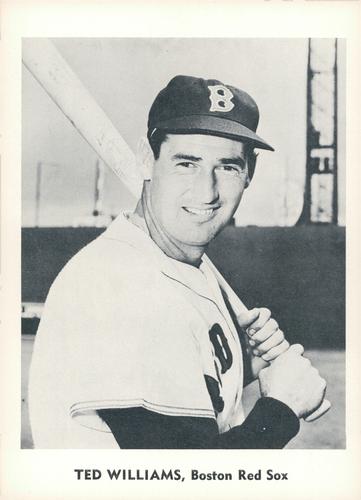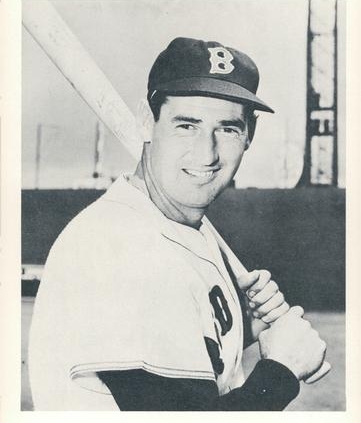June 27, 1959: As Cleveland infielders switch positions 16 times, Ted Williams homers over their heads
 It was a Saturday afternoon game at Cleveland Stadium. The Cleveland Indians (37-29) were in first place in the American League, one game ahead of the Baltimore Orioles and two games ahead of both the Chicago White Sox and New York Yankees.
It was a Saturday afternoon game at Cleveland Stadium. The Cleveland Indians (37-29) were in first place in the American League, one game ahead of the Baltimore Orioles and two games ahead of both the Chicago White Sox and New York Yankees.
The 30-37 Boston Red Sox were just a half-game above the last-place Kansas City Athletics. Red Sox manager Pinky Higgins was five days away from being fired. And the Red Sox were a little more than three weeks away from fielding their first Black ballplayer, Pumpsie Green, making them the last major-league team to have a Black player in a regular-season game.1
Cleveland, by contrast, had been one of baseball’s integration pioneers, breaking the AL’s color line with Larry Doby in 1947, winning the World Series with Doby and Satchel Paige in 1948, and featuring other Black stars like Al Smith and Minnie Miñoso since then. Against the Red Sox, manager Joe Gordon’s lineup included Miñoso in left, Puerto Rico-born Vic Power at first, and an emerging 23-year-old right-hander, Mudcat Grant, on the mound. Grant was in his second season as a starter for the Indians; he went on to win 145 games in 14 major-league seasons.
Throwing for the Red Sox was Frank Sullivan, like Grant a right-hander. The day was so hot that Sullivan had to change his uniform twice during the course of the game.2
Shortstop Don Buddin led off the game for the Red Sox and scored the game’s first run. He walked, and then ran to third base when second baseman Pete Runnels doubled to left field, the ball kicking up chalk on the line. It was the first of three hits Runnels had in the game, raising his batting average to .356.
Ted Williams came to bat, with two runners in scoring position and nobody out. A preseason neck injury had kept him out of action until May 12 and limited his production to a .202 batting average and only 3 home runs through 38 games.
Even so, the 40-year-old Williams’s appearance in the left-handed batter’s box still could provoke opponents into developing creative ways to contain him. In this instance, Gordon shifted two of his infielders – Woodie Held moved from shortstop to play second base, while Granny Hamner moved from second to short. Williams hit a high fly to short left for the inning’s first out.
With right fielder Jackie Jensen at the plate, Held and Hamner returned to their original positions. Grant threw a wild pitch, bouncing off the turf in front of the plate, and Buddin scored for a 1-0 Boston lead. Jensen walked, but third baseman Frank Malzone hit into a 5-4-3 double play.
Sullivan also walked the leadoff batter in the bottom of the first, Held, but Power lined out to his counterpart at first base, Dick Gernert, who executed an unassisted double play. Center fielder Tito Francona reached on Sullivan’s fielding error, but right fielder Rocky Colavito flied out to Williams in left.
Gernert grounded out in the top of the second. When center fielder Marty Keough came to bat – a left-handed hitter like Williams – Held and Hamner switched defensive positions once more. Keough hit the ball over their heads, for a double to right-center field.
The two middle infielders resumed their positions. Catcher Sammy White popped up to short, but Sullivan helped his own cause with an RBI single to center field. It was now 2-0, Red Sox. Buddin grounded into a force play. For the Indians in the second, Miñoso singled to left, but George Strickland struck out and Hamner lined into a double play.
Runnels singled to lead off Boston’s third. With Williams up, Held and Hamner shifted positions again, and Williams popped up to Power at first. The infield reverted to its original configuration, and Jensen grounded to Held at short, who threw to Hamner at second to start an inning-ending double play.
With one out in the bottom of the third, Grant singled to center. Held walked. Power bounced a single into center, driving in Grant. Francona struck out, and Colavito popped up to Buddin at shortstop, keeping Cleveland’s deficit at 2-1.
Both Malzone and Gernert hit outfield flies to start the fourth for Boston. When Keough came up, the middle infielders switched again. Keough grounded out to first base, Grant covering, and Held and Hamner simply returned to the dugout.
Miñoso’s leadoff double and Strickland’s walk gave the bottom of the fourth a promising start for the Indians, but Hamner lined into a double play and catcher Dick Brown struck out.
After retiring the first two batters in the top of the fifth, Grant walked Buddin and then saw Runnels double down the right-field line to make it 3-1, Red Sox.
As in Williams’s first two at-bats, the two mobile middle infielders swapped positions, but this time Williams hit the ball over all the defenders, swinging at the first pitch to send a home run out of the park. He “jammed the first pitch over the improvised fence in right field, catching the stands about 350 feet from home plate.”3 It was his fourth home run of the season and the 486th of his career.
The score was 5-1, Red Sox. Trekking back to their original positions, the Indians infielders saw another ball leave the park, Jensen’s 400-foot home run to the lower deck in left field. Malzone grounded out, third to first, to end the inning.
The Indians got two back in the bottom of the fifth. A two-out single by Power put him on first base, and Francona homered into the right-field stands, his fourth home run in the last five games.
Mike Garcia relieved Grant and pitched the sixth and seventh. There were six more infield swaps – three back-and-forths – by Held and Hamner before the game was over. Their defensive positioning for the game reads:
Held: SS-2B-SS-2B-SS-2B-SS-2B-SS-2B-SS-2B-SS-2B-SS-2B-SS
Hamner: 2B-SS-2B-SS-2B-SS-2B-SS-2B-SS-2B-SS-2B-SS-2B-SS-2B
Gordon was said to prefer “the faster-moving Held on the right side of second base.”4 The Cleveland Plain Dealer called it a “revolving infield” because “Held has more range than Hamner” so they employed it against the left-handed pull hitters, Williams and Keough.5 Only once was either infielder involved in a play following a switch, when Runnels was thrown out trying to steal second with two outs in the top of the seventh, Brown throwing to Hamner, who had returned to his original post at second base. Keough walked in the sixth. After missing a home run to right, foul by only a foot or so, Williams flied out to center in the seventh. And Keough walked again in the eighth, Dick Brodowski taking over from Garcia.
The Indians mounted a minor threat in the bottom of the eighth with a two-out single by Miñoso and a walk to Strickland. Tom Brewer relieved a tiring and depleted Sullivan and struck out Hamner.
Gene Stephens had taken over left field for Williams before the bottom of the seventh. He singled in the top of the ninth, after a walk to Buddin, but nothing came of it.
In the bottom of the ninth, Willie Jones pinch-hit for Brown. He grounded out, Brewer to Gernert. Russ Nixon pinch-hit for Brodowski. He grounded out, Gernert to Brewer. The Indians had just one out left. Held homered into the seats in right field, reducing the Red Sox’ lead to two runs, at 6-4, but Power grounded out, hitting the ball to Brewer, who threw to Gernert for the final out.
It had been two years and 10 days since Frank Sullivan – who had suffered a bad case of pneumonia in the springtime – had beaten the Indians, but he improved his season record to 4-5 with the victory. The game attracted 25,520, of whom 10,919 were “cash customers.”6
Williams finally got his fourth home run of the season and two more RBIs, lifted his average to .203, and provided the runs that made the margin of difference in a win for the Red Sox.
Acknowledgments
This article was fact-checked by Ray Danner and copy-edited by Len Levin.
Photo credit: Ted Williams, Trading Card Database.
Sources
In addition to the sources cited in the Notes, the author consulted Baseball-Reference.com and Retrosheet.org.
https://www.baseball-reference.com/boxes/CLE/CLE195906270.shtml
https://www.retrosheet.org/boxesetc/1959/B06270CLE1959.htm
Notes
1 Green debuted on July 21, 1959. The Red Sox were the last among the 16 teams to integrate in what was then considered major-league baseball. For a discussion of the subject, see Bill Nowlin, ed., Pumpsie and Progress: The Red Sox, Race, and Redemption (Burlington, Massachusetts: Rounder Books, 2010).
2 Clif Keane, “Sox Win 6-4 on Homers,” Boston Globe, June 28, 1959: 61.
3 Henry McKenna, “Red Sox Stop Indians. 6-4,” Boston Herald, June 28, 1959: 37, 38.
4 McKenna.
5 Harry Jones, “Batting Around,” Cleveland Plain Dealer, June 28, 1959: 5-C.
6 Harry Jones, “Red Sox Homers Jolt Indians, 6-4,” Cleveland Plain Dealer, June 28, 1959: 1-C.
Additional Stats
Boston Red Sox 6
Cleveland Indians 4
Cleveland Stadium
Cleveland, OH
Box Score + PBP:
Corrections? Additions?
If you can help us improve this game story, contact us.


